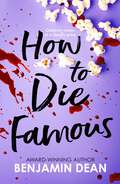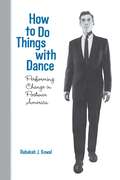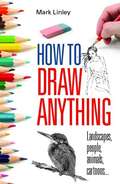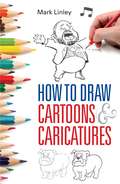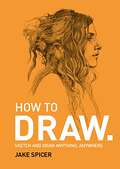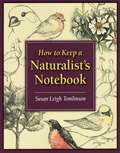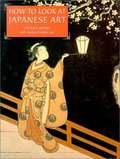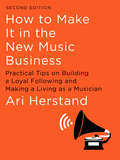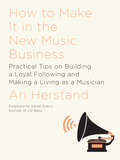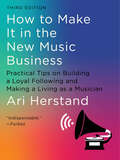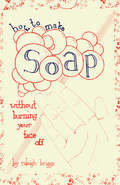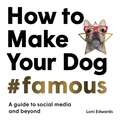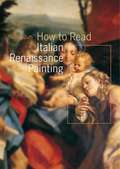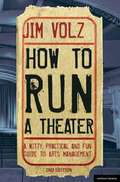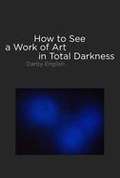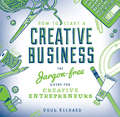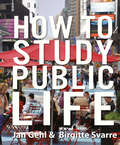- Table View
- List View
How To Deal In Antiques
by Fiona ShoopWhether you want to find the best bargains when buying antiques and collectables as a hobby, or whether you want to turn your interest in antiques into an extra income stream or full-time career, this book will help you make better deals and maximise your profits. You'll discover: - * what to buy and sell * where to buy and how to get bigger discounts * where and how to sell * using the internet for both buying and selling. * Antiques expert, Fiona Shoop, highlights the tricks of the trade to help you avoid making common but costly mistakes - and ensure that you get the best out of the antiques world.
How To Deal In Antiques, 5th Edition
by Fiona ShoopWhether you want to find the best bargains when buying antiques and collectables as a hobby, or whether you want to turn your interest in antiques into an extra income stream or full-time career, this book will help you make better deals and maximise your profits. You'll discover: - * what to buy and sell * where to buy and how to get bigger discounts * where and how to sell * using the internet for both buying and selling. * Antiques expert, Fiona Shoop, highlights the tricks of the trade to help you avoid making common but costly mistakes - and ensure that you get the best out of the antiques world.
How To Die Famous
by Benjamin DeanFrom award-winning author Benjamin Dean comes a deliciously dark and addictive YA thriller following the lives of Gen Z&’s rich and famous through the lens of an undercover teen journalist. Perfect for fans of A Good Girl's Guide to Murder and One of Us is Lying. 'A tense, page-turning YA showbiz thriller' The Guardian 'This [book] has "Netflix adaptation" written all over it.' The Bookseller London-born Abel has landed the role of a lifetime for an upcoming blockbuster. On the face of it he&’s Hollywood&’s latest teen star, but below the surface he&’s an undercover journalist on a mission to expose the &‘squeaky clean&’ entertainment industry and the part they played in his brother&’s &‘accidental&’ death. As Abel steps into the spotlight alongside fellow actors Lucky, Ryan and Ella, he soon discovers that beneath the glittering surface of fame and riches lies a darker world of secrecy, scandal and murder. Nobody is who they seem when the cameras are off, and everybody has something to hide. But who&’s next in line to die famous? Drawing on his previous career as a celebrity journalist, Benjamin Dean examines the dark underbelly of showbiz, leaving no stone unturned.PRAISE FOR BENJAMIN DEAN&’S THE KING IS DEAD: &‘Benjamin Dean has written a royal triumph.&’ Juno Dawson, author of Clean &‘All hail this exquisitely twisty, delightfully queer mystery.&’ Chelsea Pitcher, author of This Lie Will Kill You &‘A compelling thriller that stays with you long after you&’ve finished reading.&’ Kathryn Foxfield, author of Good Girls Die First &‘More jaw-dropping, OMG-twists than even the most salacious tabloid journalist could create.&’ Erik J. Brown, author of All That's Left in the World &‘One page-burning scandal after another. Benjamin Dean is YA royalty.&’ Femi Fadugba, author of The Upper World &‘Addictive, compelling, and utterly delicious.&’ Simon James Green, author of Noah Can&’t Even
How To Do Things with Dance
by Rebekah J. KowalIn postwar America, any assertion of difference from the mainstream anticommunist culture carried professional and personal risks. For this reason, modern dance artists left much of what they thought unsaid. Instead they expressed themselves in movement. How To Do Things with Dance positions modern dance as a vital critical discourse, and suggests that dances of the late 1940s and the 1950s can be seen as compelling agents of social change. Concentrating on choreographers whose artistic work conceived dance in terms of action, Rebekah J. Kowal shows how specific choreographic projects demonstrated increasing awareness of the stage as a penetrable space, one on which socially suspect or marginalized modes of being could be performed with relative impunity and exerted in the real world. Artists covered include Martha Graham, Jose Limon, Anna Sokolow, Katherine Dunham, Pearl Primus, Merce Cunningham, Paul Taylor, Donald McKayle, Talley Beatty, and Anna Halprin.
How To Draw Anything
by Mark LinleyIf you can write your name, you have enough touch to learn to draw. Let Mark Linley inspire you to pick up your pencil and create a magical masterpiece. His positive approach secures quick, accurate results and ever-growing confidence.Learn to look properly and get the basic outlines correct; include the key features but simplify what you see; understand how shading (such as dot stipple or cross-hatching) can transform a sketch; get the eye level right and see how a grid helps with the composition.Whatever you want to draw - a beautiful holiday scene, a lifelike portrait of your family or favourite pet, or even a funny cartoon to illustrate a birthday card - Mark Linley shows, in this new edition of his bestselling book, everything you need to succeed.
How To Draw Anything
by Mark LinleyIf you can write your name, you have enough touch to learn to draw. Let Mark Linley inspire you to pick up your pencil and create a magical masterpiece. His positive approach secures quick, accurate results and ever-growing confidence.Learn to look properly and get the basic outlines correct; include the key features but simplify what you see; understand how shading (such as dot stipple or cross-hatching) can transform a sketch; get the eye level right and see how a grid helps with the composition.Whatever you want to draw - a beautiful holiday scene, a lifelike portrait of your family or favourite pet, or even a funny cartoon to illustrate a birthday card - Mark Linley shows, in this new edition of his bestselling book, everything you need to succeed.
How To Draw Cartoons and Caricatures
by Mark LinleyLearn to draw the fun way! Like almost everyone in the world, you are bursting with raw artistic talent just waiting to be released. In a few deft sweeps of your pencil, capture the character of your 'victim'. Use swift strokes to create a face that has instant appeal. Exaggerate the features to make a comical caricature. Brighten up someone's day with your own tiny bit of magic!"Yes, you can do it," says Mark Linley, "and I show you exactly how!"
How To Draw Cartoons and Caricatures
by Mark LinleyLearn to draw the fun way! Like almost everyone in the world, you are bursting with raw artistic talent just waiting to be released. In a few deft sweeps of your pencil, capture the character of your 'victim'. Use swift strokes to create a face that has instant appeal. Exaggerate the features to make a comical caricature. Brighten up someone's day with your own tiny bit of magic!"Yes, you can do it," says Mark Linley, "and I show you exactly how!"
How To Draw: Sketch and draw anything, anywhere with this inspiring and practical handbook
by Jake SpicerJake Spicer wants you to learn how to draw. This is his complete course in drawing, suitable for complete beginners as well as experienced artists, and designed to help you fit drawing into your lifestyle. Tried-and-tested exercises, ranging from five-minute sketches to dedicated sessions of an hour or longer, cover every subject and location you could wish for, while accessibly written drawing theory helps you relate the technical concepts to your practice, helping you to hone your craft. Whatever your goals are, expert art tutor Jake Spicer gives you the inspiration and encouragement to draw more - and keep improving.
How To Draw: Sketch and draw anything, anywhere with this inspiring and practical handbook
by Jake SpicerJake Spicer wants you to learn how to draw. This is his complete course in drawing, suitable for complete beginners as well as experienced artists, and designed to help you fit drawing into your lifestyle. Tried-and-tested exercises, ranging from five-minute sketches to dedicated sessions of an hour or longer, cover every subject and location you could wish for, while accessibly written drawing theory helps you relate the technical concepts to your practice, helping you to hone your craft. Whatever your goals are, expert art tutor Jake Spicer gives you the inspiration and encouragement to draw more - and keep improving.
How To Draw: Sketch and draw anything, anywhere with this inspiring and practical handbook
by Jake SpicerJake Spicer wants you to learn how to draw. This is his complete course in drawing, suitable for complete beginners as well as experienced artists, and designed to help you fit drawing into your lifestyle. Tried-and-tested exercises, ranging from five-minute sketches to dedicated sessions of an hour or longer, cover every subject and location you could wish for, while accessibly written drawing theory helps you relate the technical concepts to your practice, helping you to hone your craft. Whatever your goals are, expert art tutor Jake Spicer gives you the inspiration and encouragement to draw more - and keep improving.
How To Keep A Naturalist's Notebook
by Susan Leigh TomlinsonA one-of-a-kind, art-filled how-to guide geared to wildlife students and naturalists, based on the author's college course. Pages from actual field notebooks clearly illustrate what works and why. Hints and advice for outdoorspeople with even limited artistic skills.
How To Look At Japanese Art
by Stephen Addiss Audrey SeoWesterners have long been fascinated by Japanese art, but many viewers are unable to fully enjoy the work because they are unfamiliar with its distinctive attributes. Now, Stephen Addiss presents a complete introduction to one of the world's oldest and most admired art traditions. He discusses the composition, color, form, and subject matter of more than 60 outstanding works.
How To Make It in the New Music Business (Second Edition): Practical Tips On Building A Loyal Following And Making A Living As A Musician
by Ari HerstandHailed as an “indispensable” guide (Forbes), How to Make It in the New Music Business returns in this extensively revised and expanded edition. When How to Make It in the New Music Business hit shelves in 2016, it instantly became the go-to resource for musicians eager to make a living in a turbulent industry. Widely adopted by music schools everywhere and considered “the best how- to book of its kind” (Music Connection), it inspired thousands to stop waiting around for that “big break.” Now trusted as the leading expert for “do it yourself” artists, Ari Herstand returns with this second edition, maintaining that a stable career can be built by taking advantage of the many tools at our fi ngertips: conquering social media, mastering the art of merchandising, embracing authentic fan connection, and simply learning how to persevere. Comprehensively updated to include the latest online trends and developments, it offers inspiring success stories across media such as Spotify and Instagram. The result is a must- have for anyone hoping to navigate the increasingly complex yet advantageous landscape that is the modern music industry.
How To Make It in the New Music Business: Practical Tips On Building A Loyal Following And Making A Living As A Musician
by Derek Sivers Ari Herstand"Ari is at the front of the front. He gets it. I've read a hundred how-to-make-it-in-the-music-biz books, and this one is today's definitive, comprehensive manual." —Jack Conte, 150+ million YouTube views, Pomplamoose, CEO of Patreon Forget everything you think you know about the odds of “making it” in the music industry. Today, odds mean nothing and success is not about lucky breaks. It’s about conquering social media, mastering the art of merchandising and simply working harder and being smarter than everyone else. We are living in the midst of an industry renaissance, one that has left the record companies desperately struggling to maintain their prominence, as a subculture of dedicated, DIY (do-it-yourself) musicians have taken over. These days talent is a given and success has to be earned. In 2008, Ari Herstand boldly turned in his green Starbucks apron to his manager, determined to make a living off his craft as a singer/songwriter. Almost a decade later, he has become a founding member of the new DIY movement and a self-sustaining musician, all without the help of a major label. Now, drawing from years of experience, Herstand has written the definitive guide for other like-minded artists, the ones who want to forge their own path and not follow the traditional markers of success, like record sales, hits on the radio or the amount of your label advance. Incredibly comprehensive and brutally honest throughout, How to Make It in the New Music Business covers every facet of the "new" business, including how to: Build a grass-roots fan base—and understand the modern fan Book a profitable tour, and tips for playing live, such as opening vs. headlining etiquette, and putting on a memorable show Become popular on YouTube, Spotify and SoundCloud Get songs placed in film and television Earn royalties you didn’t know existed and reach your crowdfunding goals Musicians will not only be introduced to all the tools available today but will be shown how to effectively leverage them to actually make money. More important, they will develop the mindset to be aware of new advancements both online and in the real world and always stay in tune with a constantly evolving landscape. There has never been a better time to be an independent musician. Today, fans can communicate with their idols by simply picking up their phones, artists are able to produce studio-worthy content from their basement and albums are funded not by "record men" but by generous, engaged supporters. As result, How to Make It in the New Music Business is a must-have guide for anyone hoping to navigate the increasingly complex yet advantageous landscape that is the modern music industry.
How To Make It in the New Music Business: Practical Tips on Building a Loyal Following and Making a Living as a Musician (Third)
by Ari HerstandNow Magazine: “Top 5 Music Business Books” Hailed as an “indispensable” guide (Forbes), How to Make It in the New Music Business returns in a significantly revised and expanded third edition. How to Make It in the New Music Business, since its first publication in 2016,?has become the go-to resource for musicians eager to make a living in a turbulent industry. Widely adopted by ambitious individuals and music schools across the world and considered “the best how-to book of its kind” (Music Connection), this essential work has inspired tens of thousands of aspiring artists to stop waiting around for that “big break” and take matters into their own hands. In this highly anticipated new edition, Ari Herstand reveals how to build a profitable career with the many tools at our fingertips in the post-COVID era and beyond, from conquering social media and mastering the digital landscape to embracing authentic fan connection and simply learning how to persevere. This edition breaks down these phenomena and more, resulting in a timeless must-have for anyone hoping to navigate the increasingly complex yet advantageous landscape that is the modern music business.
How To Make Soap: Without Burning Your Face Off
by Raleigh BriggsRaleigh Briggs, author of the popular Microcosm title Make Your Place, is back with another pamphlet on better, healthier living. This time around, she tackles soap-making basics, and teaches us how to create silky handmade soaps at home.<P><P> How To Make Soap contains basic directions, recipes, a list of resources, and assorted tips and tricks to make your homemade soaps special. Raleigh takes a seemingly arduous task, and makes it breezy and fun, with her charming hand-drawn illustrations and easy to follow directions. How to Make Soap is a great guide (and gift!) for the beginning soapmaker, looking for a place to start.<P><P> Advisory: Bookshare has learned that this book offers only partial accessibility. We have kept it in the collection because it is useful for some of our members. To explore further access options with us, please contact us through the Book Quality link on the right sidebar. Benetech is actively working on projects to improve accessibility issues such as these.
How To Make Your Dog #Famous: A Guide to Social Media and Beyond
by Loni EdwardsYou know your dog is the cutest but does everyone else know it too?In this book, Loni Edwards, the human behind the world's most influential pets, breaks down the path to fame. Discover insights into the success of social media's top pups and follow the essential steps on the road to fame - from crafting your brand to advocating for your pup on set. With expert guidance on how to be a good dog parent and make sure your pup is happy and healthy every step of the way, this is your one-stop guide to helping your dog win over hearts, one adorable post at a time.Featuring the stories of more than 40 of the most successful pet influencers:157 of Gemma, Amazing Graciedoodle, Barkley Sir Charles, Bertie Bert the Pom, Bronson the Bully, Brussels Sprout, Bully Baloo, Charlie the Black Shepherd, Chloe the Mini Frenchie (& Emma Bear), Coco the Maltese Dog (Coco & Cici), Cookie Malibu, Crusoe the Celebrity Dachshund, Daily Dougie, Dog named Stella, Ducky the Yorkie, Frame the Weim, Gone to the Snow Dogs, Harlow and Sage, Hi Wiley, Kelly Bove, Lilybug, Lizzie Bear, Louboutina the Hugging Dog, Maya Polar Bear, Mervin the Chihuahua, Milo and Noah, MJ the Beagle, Mr. Biggie, Popeye the Foodie, Puggy Smalls, Reagandoodle, Remix the Dog, Rocco Roni, Super Corgi Jojo, Super Scooty, Tatum, That Goldendoodle, The Bike Dog, Tika the Iggy, Tuna Melts my Heart, Tupey the Borzoi, Verpinscht, Winnie the Cocker, Wolfgang 2242
How To Make Your Dog #Famous: A Guide to Social Media and Beyond
by Loni EdwardsYou know your dog is the cutest but does everyone else know it too?In this book, Loni Edwards, the human behind the world's most influential pets, breaks down the path to fame. Discover insights into the success of social media's top pups and follow the essential steps on the road to fame - from crafting your brand to advocating for your pup on set. With expert guidance on how to be a good dog parent and make sure your pup is happy and healthy every step of the way, this is your one-stop guide to helping your dog win over hearts, one adorable post at a time.Featuring the stories of more than 40 of the most successful pet influencers:157 of Gemma, Amazing Graciedoodle, Barkley Sir Charles, Bertie Bert the Pom, Bronson the Bully, Brussels Sprout, Bully Baloo, Charlie the Black Shepherd, Chloe the Mini Frenchie (& Emma Bear), Coco the Maltese Dog (Coco & Cici), Cookie Malibu, Crusoe the Celebrity Dachshund, Daily Dougie, Dog named Stella, Ducky the Yorkie, Frame the Weim, Gone to the Snow Dogs, Harlow and Sage, Hi Wiley, Kelly Bove, Lilybug, Lizzie Bear, Louboutina the Hugging Dog, Maya Polar Bear, Mervin the Chihuahua, Milo and Noah, MJ the Beagle, Mr. Biggie, Popeye the Foodie, Puggy Smalls, Reagandoodle, Remix the Dog, Rocco Roni, Super Corgi Jojo, Super Scooty, Tatum, That Goldendoodle, The Bike Dog, Tika the Iggy, Tuna Melts my Heart, Tupey the Borzoi, Verpinscht, Winnie the Cocker, Wolfgang 2242
How To Read Italian Renaissance Painting
by Stefano ZuffiFilled with great masterpieces by such artists as Botticelli, Leonardo, Raphael, Michelangelo, Masaccio, Piero della Francesca, Mantegna, and Titian, How to Read Italian Renaissance Painting takes the reader into their world. As in the internationally successful and innovative How to Read a Painting, each spread uses an important painting as a way to explain a key concept, with numerous large details. Here, 180 works illuminate key ideas in Renaissance painting, from "perpective" and "the golden section" to "grace" and "symbolism." In addition, there are brief biographies of the major artists. The result is an original, accessible, and affordable volume that offers an introduction into the art and culture of the Italian Renaissance.
How To Run A Theatre: A Witty, Practical And Fun Guide To Arts Management
by Jim VolzThe first edition of How to Run a Theatre sold out within months of initial publication and it took the cries of the field and pleadings of professors who use the book in their university classes to encourage me to search for a publisher for this second edition. <P><P>Fortunately, publisher Jenny Ridout with London's esteemed Methuen Drama/A & C Black Publishers Limited took time to review the book and take it to her Board. The results are before you - an updated edition with new sections, new contacts and new teaching tools.
How To See A Work Of Art In Total Darkness
by Darby EnglishGoing beyond the 'blackness' of black art to examine the integrative and interdisciplinary practices of Kara Walker, Fred Wilson, Isaac Julien, Glenn Ligon, and William Pope.L--five contemporary black artists in whose work race plays anything but a defining role. Work by black artists today is almost uniformly understood in terms of its "blackness," with audiences often expecting or requiring it to "represent" the race. In How to See a Work of Art in Total Darkness, Darby English shows how severely such expectations limit the scope of our knowledge about this work and how different it looks when approached on its own terms. Refusing to grant racial blackness--his metaphorical "total darkness"--primacy over his subjects' other concerns and contexts, he brings to light problems and possibilities that arise when questions of artistic priority and freedom come into contact, or even conflict, with those of cultural obligation. English examines the integrative and interdisciplinary strategies of five contemporary artists--Kara Walker, Fred Wilson, Isaac Julien, Glenn Ligon, and William Pope.L--stressing the ways in which this work at once reflects and alters our view of its informing context: the advent of postmodernity in late twentieth-century American art and culture. The necessity for "black art" comes both from antiblack racism and resistances to it, from both segregation and efforts to imagine an autonomous domain of black culture. Yet to judge by the work of many contemporary practitioners, English writes, black art is increasingly less able--and black artists less willing--to maintain its standing as a realm apart. Through close examinations of Walker's controversial silhouettes' insubordinate reply to pictorial tradition, Wilson's and Julien's distinct approaches to institutional critique, Ligon's text paintings' struggle with modernisms, and Pope.L's vexing performance interventions, English grounds his contention that to understand this work is to displace race from its central location in our interpretation and to grant right of way to the work's historical, cultural, and aesthetic specificity.
How To Sharpen A Knife & Care For Your Collection
by Dexter Ewing James Morgan AyresDon't miss this first-ever knife maintenance, sharpening and care eBook from BLADE Magazine and BladeMag.com. Researched and extensive feature articles cover how to sharpen a knife, as well as the full range of knife sharpeners, rust preventatives, lubricants, storage, display and much more. The world's best knife writers were assigned to the task of educating readers on how to maintain, hone and care for their knives.
How To Start a Creative Business: The Jargon-Free Guide for Creative Entrepreneurs
by Doug RichardThis user-friendly and attractive guide shows creative people how to turn their hobbies into sustainable lifestyle businesses.Based on a unique 10-question formula, the book provides comprehensive start-up business advice.The jargon-free information is brought to life with real-life case studies from a range of creative start-ups and online resources that help you to develop your own business goals and plans
How To Study Public Life
by Jan Gehl Birgitte SvarreHow do we accommodate a growing urban population in a way that is sustainable, equitable, and inviting? This question is becoming increasingly urgent to answer as we face diminishing fossil-fuel resources and the effects of a changing climate while global cities continue to compete to be the most vibrant centers of culture, knowledge, and finance. Jan Gehl has been examining this question since the 1960s, when few urban designers or planners were thinking about designing cities for people. But given the unpredictable, complex and ephemeral nature of life in cities, how can we best design public infrastructure--vital to cities for getting from place to place, or staying in place--for human use? Studying city life and understanding the factors that encourage or discourage use is the key to designing inviting public space. In How to Study Public Life Jan Gehl and Birgitte Svarre draw from their combined experience of over 50 years to provide a history of public-life study as well as methods and tools necessary to recapture city life as an important planning dimension. This type of systematic study began in earnest in the 1960s, when several researchers and journalists on different continents criticized urban planning for having forgotten life in the city. City life studies provide knowledge about human behavior in the built environment in an attempt to put it on an equal footing with knowledge about urban elements such as buildings and transport systems. Studies can be used as input in the decision-making process, as part of overall planning, or in designing individual projects such as streets, squares or parks. The original goal is still the goal today: to recapture city life as an important planning dimension. Anyone interested in improving city life will find inspiration, tools, and examples in this invaluable guide.

